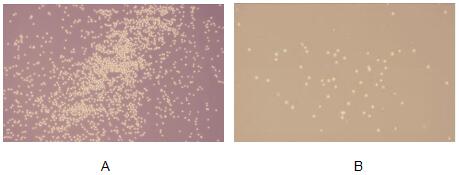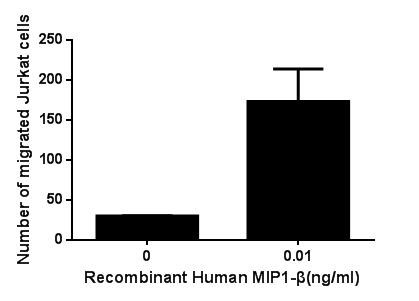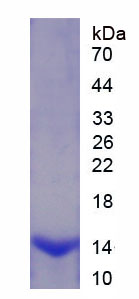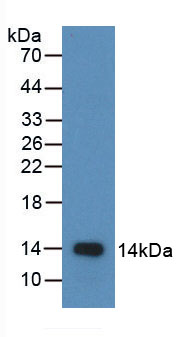
Details
ACTIVITY TEST
Buffer Formulation 20mM Tris, 150mM NaCl, pH8.0, containing 1mM EDTA, 1mM DTT, 0.01% SKL, 5% Trehalose and Proclin300. Traits Freeze-dried powder Purity > 97% Isoelectric Point 4.8 Applications Cell culture; Activity Assays.

Macrophage inflammatory protein-1β (MIP-1β), also known as CCL4 is a CC chemokine with specificity for CCR5 receptors. It is a chemoattractant for natural killer cells, monocytes and a variety of other immune cells. MIP-1β is a kind of chemotactic cytokine. Thus, chemotaxis assay used 24-well microchemotaxis system was undertaken to detect the chemotactic effect of MIP-1β on the human T-lymphocyte leukemia cell line Jurkat. Briefly, Jurkat cells were seeded into the upper chambers (100uL cell suspension, 5×105 cells/mL in RPMI 1640 with FBS free) and recombinant human MIP-1β (0.0001ng/mL, 0.001ng/mL, 0.1ng/mL, 1ng/mL, 10ng/mL, 100ng/mL diluted separately in serum free RPMI 1640) was added in lower chamber with a polycarbonate filter (8um pore size) used to separate the two compartments. After incubation at 37℃ with 5% CO2 for 2h, the <br/>filter was removed, then cells in low chamber were observed by inverted microscope at low magnification (×100) and the number of migrated cells were counted at high magnification (×200) randomly (five fields for each filter). Result shows recombinant human MIP-1β is able to induce migration of Jurkat cells. The migrated Jurkat cells in low chamber at low magnification (×100) were shown in Figure 1. Five fields of each chamber were randomly chosen, and the migrated cells were counted at high magnification (×200). Statistical results were shown in Figure 2. The optimum chemotaxis of MIP-1β occurs at 0.1~10pg/mL.<br/>(A)Jurkat cells were seeded into the upper chambers and serum free RPMI 1640 with 0.01ng/mL MIP-1β was added in lower chamber, then cells in lower chamber were observed at low magnification (×100) after incubation for 2h; <br/>(B)Jurkat cells were seeded into the upper chambers and serum free RPMI 1640 without MIP-1β was added in lower chamber, then cells in lower chamber were observed at low magnification (×100) after incubation for 2h.<br/>Figure. The chemotactic effect of recombinant human MIP-1β on Jurkat cells.

Figure. The chemotactic effect of recombinant human MIP1-βon Jurkat cells.
USAGE
Reconstitute in 20mM Tris, 150mM NaCl (pH8.0) to a concentration of 0.1-1.0 mg/mL. Do not vortex.
STORAGE
Avoid repeated freeze/thaw cycles. Store at 2-8°C for one month. Aliquot and store at -80°C for 12 months.
STABILITY
The thermal stability is described by the loss rate. The loss rate was determined by accelerated thermal degradation test, that is, incubate the protein at 37°C for 48h, and no obvious degradation and precipitation were observed. The loss rate is less than 5% within the expiration date under appropriate storage condition.
Image

Figure. SDS-PAGE

Sample: Recombinant MIP1b, Human;
Antibody: Rabbit Anti-Human MIP1b Ab (PAA093Hu02)
Figure. Western Blot
Bought notes(bought amounts latest0)
User Comment(Total0User Comment Num)
- No comment


 +86 571 56623320
+86 571 56623320
 +86 18668110335
+86 18668110335

